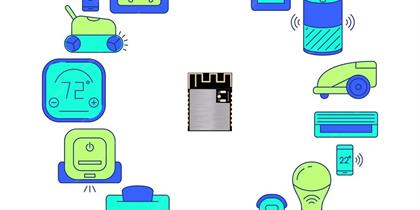
Navigating the Bluetooth Protocol Stack: An Insight into Event Handling
September 14, 2024

In the intricate world of wireless communication, Bluetooth Protocol Stack has established itself as a cornerstone technology, facilitating seamless connectivity between a plethora of devices. At the heart of this technology lies the Bluetooth protocol stack, a structured set of protocols that govern how devices communicate. One of the most critical aspects of the protocol stack is event handling, which is responsible for managing the state and behavior of Bluetooth devices during various stages of operation. In this article, we will delve into the nuances of Bluetooth protocol stack event handling, exploring its significance and the mechanisms that drive it.
The Bluetooth Protocol Stack Overview
The Bluetooth protocol stack is often visualized as a series of layers, each with a specific role in the communication process. These layers include the Physical Layer, Link Layer, Host Controller Interface (HCI), Logical Link Control and Adaptation Protocol (L2CAP), Service Discovery Protocol (SDP), and higher-level protocols like RFCOMM and OBEX. Event handling is a cross-layer phenomenon, with each layer responding to specific events and invoking actions that maintain the flow and integrity of data exchange.
Event Handling at the Physical Layer
At the Physical Layer, events are primarily related to radio frequency (RF) signal management. The receiver is constantly monitoring the RF environment for incoming signals, and when a signal is detected, an event is triggered. This event sets off a chain reaction within the protocol stack, with each layer preparing to receive and process the incoming data.
Link Layer Event Management
As the data ascends through the layers, the Link Layer comes into play. It is here where events such as packet reception, transmission completion, and error detection are managed. The Link Layer is responsible for ensuring that data is transmitted reliably, using techniques like packet retransmission and error correction. When a transmission is successfully completed, an event is generated to signal the upper layers that the data is on its way.
HCI Layer and Event Interface
The HCI layer serves as an interface between the lower layers and the host controller, which manages the Bluetooth hardware. Events at this layer are crucial for the host controller to understand the status of the Bluetooth hardware and to make decisions accordingly. For instance, when a device comes into range, an HCI event is generated to notify the upper layers, which can then initiate device discovery or connection establishment procedures.
L2CAP and Event-Driven Data Management
L2CAP is responsible for segmenting and reassembling data packets, managing the quality of service (QoS), and providing multiplexing of multiple logical channels over a single Bluetooth connection. Events in L2CAP are triggered by the need to open or close channels, transmit data, or handle retransmissions. These events are essential for maintaining the efficiency and reliability of the data transfer process.
SDP and Service Discovery Events
SDP is a protocol that allows Bluetooth devices to discover and learn about services offered by other devices. When a device initiates a service search, SDP generates events that contain information about available services, their attributes, and how to access them. This event-driven approach enables devices to dynamically discover and interact with services, facilitating a plug-and-play experience.
Application-Level Event Handling
As we move up the stack to application-level protocols like RFCOMM and OBEX, events take on a more application-centric focus. RFCOMM, for example, provides a serial port emulation service that applications can use to establish a reliable, bidirectional communication channel. Events at this layer might include channel establishment, data reception, and disconnection notifications. OBEX, on the other hand, is used for object exchange and can generate events related to file transfers, database synchronization, and other data exchange operations.
Challenges and Strategies in Event Handling
Event handling in the Bluetooth protocol stack is not just about responding to stimuli; it’s about orchestrating a harmonious dance of devices that must communicate efficiently and effectively. The stack must be able to handle concurrent events, prioritize critical operations, and recover gracefully from errors or interruptions.
Conclusion
In conclusion, event handling is a fundamental aspect of the Bluetooth protocol stack that ensures the smooth operation of Bluetooth devices in diverse and dynamic environments. It is a complex yet fascinating area of study that involves understanding the interplay between hardware, software, and wireless communication principles. As Bluetooth technology continues to evolve, so too will the sophistication of its event handling mechanisms, paving the way for even more innovative and seamless wireless experiences.
You Might Like Also

In the quest for cleaner and healthier indoor air, Bluetooth modules have become an integral part of modern air purifiers. These compact devices enable wireless communication between the air purifier and other systems, such as smartphones or home automation networks. By integrating Bluetooth technology, air purifiers can offer a range of advanced f Read More

In the modern landscape of wireless technology, Bluetooth modules have become indispensable components, enabling a myriad of applications that enhance our daily lives. These compact devices, embedded within a wide array of products, facilitate communication and connectivity with minimal effort. This article delves into the diverse applications of B Read More

The Versatility of Bluetooth Modules: Unleashing Connectivity
In the realm of wireless communication, Bluetooth modules have emerged as the Swiss Army knife of connectivity, enabling seamless interaction between devices over short distances. These compact devices have become indispensable in a variety of applications, from consumer electronics to industrial automation. Bluetooth modules are the silent workhor Read More

Enriching the Museum Experience: The Role of Bluetooth Beacons
Bluetooth Beacons are wireless transmitters that can detect the presence of mobile devices within their vicinity. In a museum setting, beacons can be placed at various exhibits to provide a wealth of information and interactive content to visitors. As a visitor approaches an exhibit, their device can receive a signal from the beacon, triggering an Read More

Bluetooth beacon used in Indoor Positioning Systems
Bluetooth beacons have become an essential component in Indoor Positioning Systems (IPS), providing accurate location data that enhances various applications within controlled environments. In smart retail settings, beacons play a crucial role in enhancing customer experiences, optimizing store operations, and driving business insights. Read More

The role of Bluetooth beacons in RTLS
Bluetooth beacons are playing an increasingly vital role in Real-Time Locating Systems (RTLS), particularly within the context of warehouse management. These tiny, yet powerful devices, are redefining the way warehouses operate, offering a new level of efficiency and precision that is transforming inventory tracking and asset management. Read More











